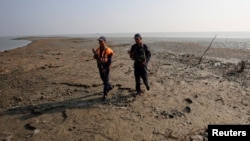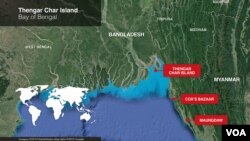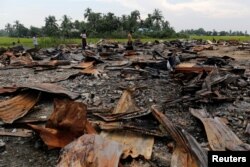Bangladesh has proposed moving an influx of refugees from Myanmar to an isolated island that only emerged from the sea 11 years ago, partially floods at high tide and disappears completely for three months during the annual monsoon season.
Local officials say extensive time – likely years -- and work would be required, at significant expense, to make Thengar Char habitable. The only regular residents now are a handful of water buffalo, though pirates and other criminals reportedly make use of it occasionally.
The prospect of living there is leading some of the ethnic Rohingya refugees to return to homes they fled due to rapes, arson and extrajudicial killings that they blame largely on Myanmar’s powerful military.
“There was a lot of concern among the refugees when they heard about it,” said Vivian Tan, a U.N. High Commissioner for Refugees representative who has been involved in the Rohingya issue. “They heard no one lives there. They’re concerned about food. They’re concerned about drinking water. They’re concerned with where they can live. There’s a huge flood risk. It sounds like it’s not very hospitable.”
Thengar Char was formed by the 1 billion tons of silt that flow every year from the peaks of the Himalayas to the turbid waters of Bangladesh’s Meghna estuary in the Bay of Bengal. About 59 kilometers and a two-hour boat ride from the coast, it covers about 186 square kilometers, much of it marshy with a shoreline that looks ready to crumble.
The monsoons bring not only heavy rains that swamp the island, but strong winds that also concern aid agencies. Human Rights Watch has called it a “human rights and humanitarian disaster in the making.” There are no roads, let alone cell phone service.
One key reason for wanting to move the refugees is clear. Two camps of registered Rohingyas (there are about 6 other smaller camps with non-registered Rohingyas) are located at Cox’s Bazaar, a district that includes a long beach that Bangladesh would like to develop for tourism. But the government finds itself stuck between the needs of its own impoverished populace and international policies against forcing refugees to return to the conditions that they fled.
“UNHCR has been very clear: there has to be a feasibility study, there must be consultation, and it must be voluntary,” Tan said. “There needs to be a clear overview on what needs to be done for better planning.”
The estimated 1 million Rohingya, who are mostly Muslims, face official and social discrimination in Myanmar and are generally denied citizenship, even if their families have lived there for generations.
A wave of Rohingya crossed into Bangladesh from Rakhine state in 2012 to flee violence from the country’s Buddhist majority, and others have left since then. However, Rohingyas started to cross inside Bangladesh in 1978. Bangladesh broached the idea of a relocation plan in 2014.
On October 9, nine policemen were killed in Rakhine in an attack blamed on Rohingya insurgents. Myanmar's military launched a "clearance operation" in the area to ferret out the insurgents. Soon after the four-month operation started, Rohingya began fleeing the area, accusing soldiers, police and local Buddhist groups who accompanied the forces during the raids, of abuses, including rapes, killings and arson. UNHCR has said the actions very likely constituted "crimes against humanity."
Myanmar’s military has denied any abuses and says only 100 Rohingya were killed, while two senior U.N. officials working among the refugees said more than 1,000 may have died. About 100,000 are estimated to have left, 70,000 to Bangladesh and 30,000 elsewhere in Myanmar.
Bangladesh doesn’t really know how big the refugee issue is and has been conducting a census of the Rohingya. Unofficial estimates put their number at 200,000 to 500,000.
About 33,000 registered refugees live in the squalid, overcrowded Cox’s Bazaar camps, mostly in shelters made of bamboo and plastic the thickness of garbage bags. Several other camps have sprouted up, and some refugees have found temporary homes among the native Bengalis.
Despite criticism of the plan to move the refugees to Thengar Char – an earlier proposal to shift them to a populated island was abandoned -- the government has said it plans to push ahead, though there is no timeline or other specifics.
At the bare minimum, aid officials say, the government would need to build an embankment around the island to prevent flooding and create shelters from cyclones. There’s no fresh water. Other infrastructure would be needed, including schools. Security would have to be bolstered.
The government has put out feelers for outside aid or grants to fund the project, presumably hoping the refugees would leave at some point, allowing Bangladeshis to take advantage of the improvements.
As they wait to learn Bangladesh’s plan for them, the Rohingya continue to be victims. The conditions they live in leave them open to disease. Some have become prey for human traffickers and drug smugglers, and that would likely continue if they move to an island already used by criminals.
It’s unclear if those who crossed back into Myanmar plan to stay or just want to get their families and whatever is left of their possessions before leaving again. If that’s the case and they are forced or coerced into moving to the island, they could launch a second exodus by sea to India or Indonesia, shifting their burden elsewhere.










